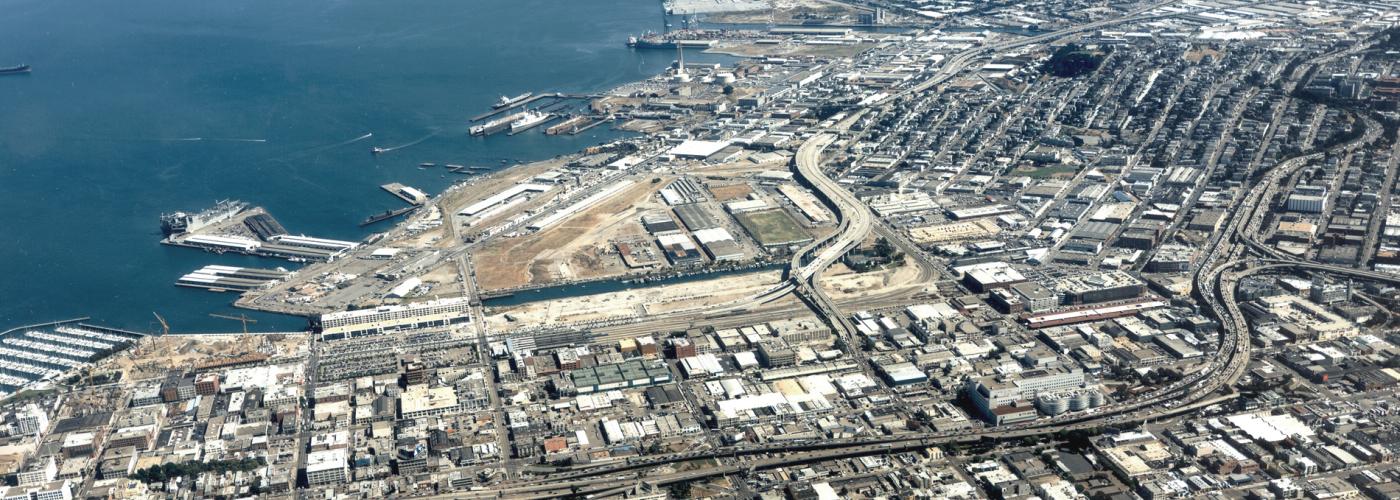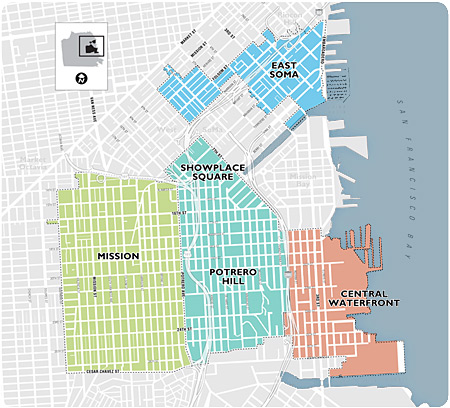In January 2009, the City adopted the Eastern Neighborhoods Plans, including plans for the future growth, development, and preservation of a number of neighborhoods on San Francisco’s east side: SoMa, Mission, Showplace Square/Potrero Hill, and Central Waterfront. The Eastern Neighborhoods Plans created new policies, land use regulations, implementation projects, and funding measures for these neighborhoods.
The Plans balance the need to protect industrial uses with the need to accommodate growth and create complete neighborhoods. In response to what had been growing conflicts between light-industrial uses and encroaching office and residential uses, the Plans provide clarity on where industrial lands are to be preserved and where and under what conditions new development can be built.
The Eastern Neighborhoods Plans enable the transition of about half of the area’s industrial lands to allow for new housing. The other half is reserved for “Production, Distribution, and Repair” (or PDR) uses, such as warehouses, distribution centers, caterers, art production, and other similar light-industrial activities. Housing and office uses are generally not allowed in these areas.
The Eastern Neighborhoods Plans also include policies and mechanisms to help assure that new growth happens to assure “complete neighborhoods,” or neighborhoods that provide safe and convenient access to shopping and services, affordable housing, open space, buildings designed to be welcoming and engaging to pedestrians, and a transit-oriented public realm that supports the needs of people of all ages and abilities.
About the Program
The Mission, Central Waterfront, East South of Market and Showplace Square/Potrero Hill neighborhoods are home to much of the city's industrially-zoned land. For the last 10 to 15 years, these neighborhoods have been changing and have seen growing land use conflicts, where residential and office development has begun to compete with industrial uses. How should we plan for the future of these areas? Should we allow housing and offices to gradually predominate or should we seek to create a balance of some sort? Does the City need to keep a place for production, distribution and repair businesses, as well as the arts? How much space should we provide for high-tech industries? How much new housing should be made affordable? How can necessary improvements to neighborhood parks and transit be funded? Resolving these difficult questions – with an emphasis on balance – is at the heart of the Eastern Neighborhoods Program.
Community Planning Process
The Eastern Neighborhoods community planning process began in 2001 with the goal of developing new zoning controls for the industrial portions of these neighborhoods. A series of workshops were conducted in each area where stakeholders articulated goals for their neighborhood, considered how new land use regulations (zoning) might promote these goals, and created several rezoning options representing variations on the amount of industrial land to retain for employment and business activity. In February 2004, the Planning Commission established interim policies for East SoMa, the Mission, and Showplace Square/Potrero Hill; in 2005, the community planning process expanded to address other issues critical to these communities. The Planning Department began working with the neighborhood stakeholders to create Area Plans for each neighborhood and in spring 2008, a series of adoption hearings were held to evaluate the Plans before they are formally adopted and become part of the City's General Plan. Legislation was passed by the Board of Supervisors on December 9, 2008.
Goals of the Eastern Neighborhood Plans
People and Neighborhoods
- Encourage new housing at appropriate locations and make it as affordable as possible to a range of city residents
- Plan for transportation, open space, community facilities and other critical elements of complete neighborhoods
The Economy and Jobs
- Reserve sufficient space for production, distribution and repair activities, in order to support the city’s economy and provide good jobs for residents
- Take steps to provide space for new industries that bring innovation and flexibility to the city’s economy
Area and Implementation Plans
The Eastern Neighborhood Plans include Area Plans (policy documents within the San Francisco General Plan), Planning Code changes, and funding and implementation measures for new and enhanced streets, transit, open space, and community facilities.
Key Components of the Community Planning Process

Area Plans - Building Complete Neighborhoods
In response to the goals and ongoing community input, an Area Plan was created for each neighborhood.
Area Plans and Implementation DocumentsZoning – Balancing the Use of Land
The Eastern Neighborhoods Program will include new zoning controls that specify what land uses will be permitted in the future.
Zoning
Public Benefits Including Affordable Housing
As portions of neighborhoods transform from largely PDR to residential, a variety of community needs will be created.
Public BenefitsImplementing the Eastern Neighborhoods Plans
Prioritizing Infrastructure and Community Improvements
Projects are typically constructed by City agencies such as the SFMTA, SF Public Works and the Recreation and Parks Department. The Eastern Neighborhoods Plans included impact fees on new development to help pay for a portion of needed infrastructure to help serve all the new residents and employees that come with new development. The City supplements these fees with other funding sources such as bonds, transportation sales taxes, and grants to fully fund infrastructure projects.
In some cases, known as in-kind agreements, private developments build public improvements directly instead of paying some or all of their required fees.
Funding decisions are made through the City’s Capital Planning process. There are many places for community input on how to prioritize projects for funding. The Eastern Neighborhoods Community Advisory Committee (CAC) advises the City on how to prioritize development fees for infrastructure projects and community improvements.
The plan for how to spend development fees is brought to the City’s Capital Planning Committee for approval each year, and is adopted in the City’s annual budget. The Planning Department produces an annual report, the Interagency Plan Implementation Committee (IPIC) Report, that describes the uses of development fees for infrastructure projects and community improvements over the next five years.
Getting Involved
Attend Eastern Neighborhoods CAC meetings
Discussion of impact fee spending is generally concentrated in the months of August through November.
Eastern Neighborhoods CAC members
There are often neighborhood-based meetings to discuss how to fund and build infrastructure projects in your neighborhood.
Attend Capital Planning Committee meetings
The Capital Planning Committee typically hears about the Interagency Plan Implementation Committee Annual Report in January or February of each year.
Planning Department Contact
Ilaria Salvadori
628.652.7441
ilaria.salvadori@sfgov.org
Archives and Other Resources
Environmental Impact Report (EIR) Case No. 2004.0160E
Eastern Neighborhoods Rezoning and Area Plan
- Introduction, Summary
- Project Description
- Intro to Analysis; Land Use; Plans and Policies
- Visual Quality and Urban Design
- Visual Quality and Urban Design - continued
- Population, Housing, and Employment
- Transportation; Noise; Air Quality
- Parks; Shadow; Archeological; Cultural; Hazardous Materials; Other Items
- Mitigation and Improvement Measures; Significant Effects; Alternatives
- Comments and Responses
- Comments and Responses - continued
- Comments and Responses - continued
- Appendices
- MMRP
- Addendum - Design Educational Special Use District (1111 8th Street)
- Addendum #2 - UMU Heights Amendment
- Addendum #3 - Dogpatch Public Realm Plan

